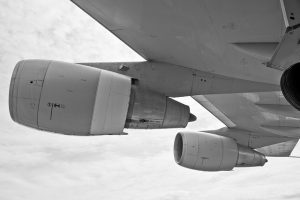
Turbofan engines are synonymous with the commercial aviation industry. With the exception of small passenger jets, most commercial jets use them as their main source of propulsion.
Not to be confused with a turbojet, a turbofan is a type of airbreathing jet engine. It features a fan that draws air into the compressor. When compared to other types of jet engines, turbofans are more efficient. This makes them a popular choice among airlines. Below is a list of some of the most common parts of a turbofan.
Inlet
The inlet is the outermost part of a turbofan. As shown in the photo above, it’s essentially a cylindrical shell or body that houses the engine and its respective components. It’s known as an “inlet” because it functions as an air intake. Air will enter the turbofan through the inlet.
Fan
All turbofans have a fan; that’s one of the main ways in which they are distinguished from turbojets. After entering the inlet, some of the air will go around the fan — known as “bypass air” — and some of the air will go through the fan. The fan consists of multiple blades that spin quickly to draw in air.
Compressor
Another essential part of a turbofan is the compressor. The compressor’s job is to squeeze and compress the air. Why is this necessary exactly? Turbofans rely on combustion for propulsion. When compressed, the temperature of the air will increase, and a greater volume of air will fit into the turbofan, resulting in greater combustion. Turbofans have a compressor directly behind the fan, and this part is responsible for compressing the air before combustion occurs.
Fuel Injector
The fuel injector is responsible for injecting fuel into the turbofan. Like with other combustion engines, turbofans require a mixture of fuel and air. They get air from the inlet and fan, and turbofans get fuel from the fuel injector. The fuel injector sprays fuel into the turbofan where it mixes with air before being burned.
Combustion Chamber
The combustion chamber is where the magic happens. Also known as the burner, it’s an enclosed chamber that’s designed to burn fuel and air. The mixture of fuel and air will enter the turbofan’s combustion chamber, at which point it will be ignited. Ignition will create a miniature and controlled explosion within the combustion chamber.
Exhaust Nozzle
Turbofans also have an exhaust nozzle. It’s considered the final stage of a turbofan’s operations. Combustion will create hot exhaust gases. These hot gases will travel out the back the turbofan through a narrow tube-like part, which is the exhaust nozzle.



